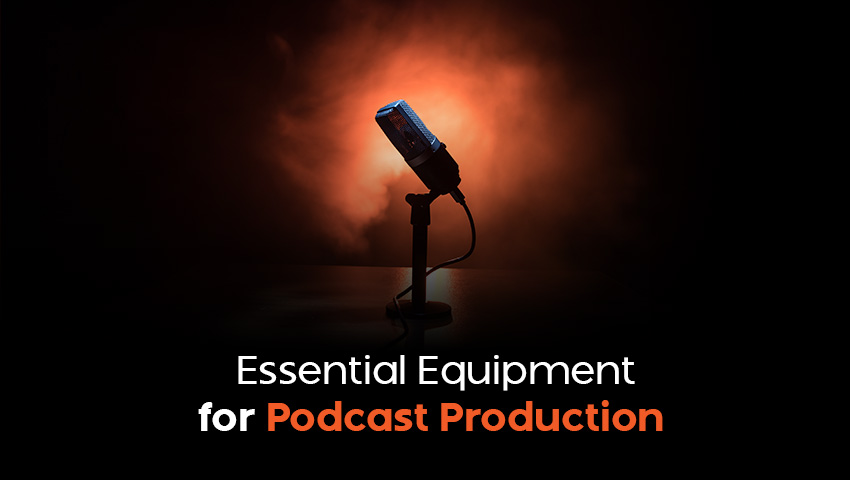
Starting a podcast is a creative and engaging way to share your ideas, connect with an audience, or promote a brand. However, to ensure high-quality sound and professional production, you need the right equipment. Whether you're a beginner or an experienced podcaster, having the right tools will make a big difference in the final product. In this guide, we'll explore the essential equipment you need to kickstart your podcast production journey.
The microphone is the most critical piece of equipment for any podcast. A good quality microphone captures clear and crisp audio, ensuring your listeners can focus on your content without being distracted by poor sound quality. There are two main types of microphones to consider:
1. Dynamic Microphones: Durable and great for recording in environments with background noise, dynamic mics are ideal for beginners or podcasters without a fully soundproofed studio.
2. Condenser Microphones: Offering higher sensitivity and capturing more detail, condenser mics are best for controlled, quiet environments like a dedicated recording studio.
Popular options:
• Shure SM7B (dynamic)
• Audio-Technica AT2020 (condenser)
An audio interface is crucial if you’re using an XLR microphone (which most professional-grade mics are). It converts your analog voice signals into digital data that your computer can process. An interface also ensures high-quality sound transmission and often provides additional features like gain control and headphone monitoring.
Popular options:
• Focusrite Scarlett 2i2
• PreSonus AudioBox USB
Monitoring your audio in real-time is essential for ensuring consistent sound quality and detecting issues like background noise, mic distortion, or vocal peaks. Closed-back headphones are recommended because they prevent sound from leaking into your microphone during recording.
Popular options:
• Audio-Technica ATH-M50x
• Beyerdynamic DT 770 Pro
A pop filter helps reduce harsh sounds caused by plosives (like “P” and “B” sounds) that can cause distortion in your recordings. Placing a pop filter in front of your microphone softens these sounds, ensuring smoother and more professional-quality audio.
Popular options:
• Aokeo Pop Filter
• Neewer NW(B-3)
A boom arm or microphone stand allows you to position your microphone for the best audio capture while keeping your desk clutter-free. A boom arm, in particular, gives you flexibility in positioning and reduces vibrations from desk movements that can be picked up by your mic.
Popular options:
• RODE PSA1 Boom Arm
• InnoGear Microphone Stand
A shock mount helps to minimize noise caused by vibrations, whether from typing, bumping the desk, or even adjusting the microphone. This ensures that your recordings are free from unwanted background noise.
Popular options:
• Audio-Technica AT8458
• Rycote InVision USM
A mixer allows for real-time control over your audio levels, especially if you’re recording multiple people at once. It gives you the ability to adjust microphone levels, add effects, and blend sounds live during your recording session. While not necessary for beginners, a mixer becomes valuable for more complex podcast setups.
Popular options:
• Behringer Xenyx Q802USB
• Yamaha MG10
A Digital Audio Workstation (DAW) is the software you’ll use to record, edit, and mix your podcast audio. Many options are available, ranging from beginner-friendly programs to professional-grade software.
Popular options:
• Audacity (Free)
• Adobe Audition
• GarageBand (for Mac users)
Once your podcast is recorded and edited, you’ll need a platform to host and distribute it. A podcast hosting platform stores your audio files and helps distribute them to podcast directories like Spotify, Apple Podcasts, and Google Podcasts.
Popular options:
• Buzzsprout
• Anchor
• Libsyn
For professional sound quality, especially in a home studio, consider using acoustic panels, foam pads, or diffusers to reduce echo and background noise. This equipment ensures your voice sounds clear and doesn’t pick up unwanted reverberation.
Popular options:
• Auralex Acoustics Studiofoam
• ATS Acoustic Panels
The right equipment is the foundation of a successful podcast. Whether you're just starting or looking to upgrade your setup, investing in high-quality tools will significantly improve your podcast’s audio quality and overall production value. From the microphone to the hosting platform, every piece plays a crucial role in creating a professional podcast that stands out in today’s competitive landscape.
If you're looking to take your podcast to the next level, Ithmar Media offers comprehensive podcast production services, including high-quality audio recording, editing, and post-production. With our expert team and high-quality equipment, we ensure that every detail of your podcast is handled with precision, allowing you to focus on delivering great content.
Contact us to discover how our professional podcast production services can help you create a podcast that stands out and resonates with your audience
Podcasting is storytelling at its best. -Alex Blumberg